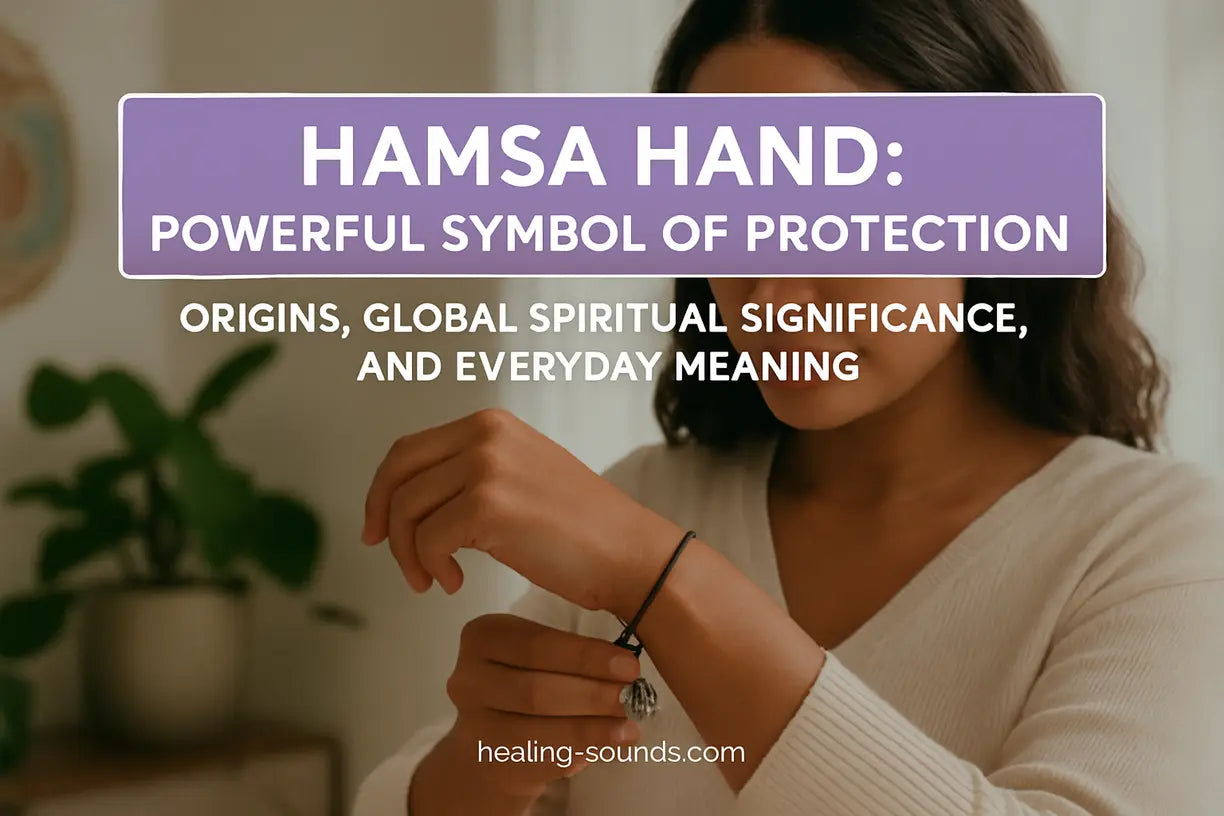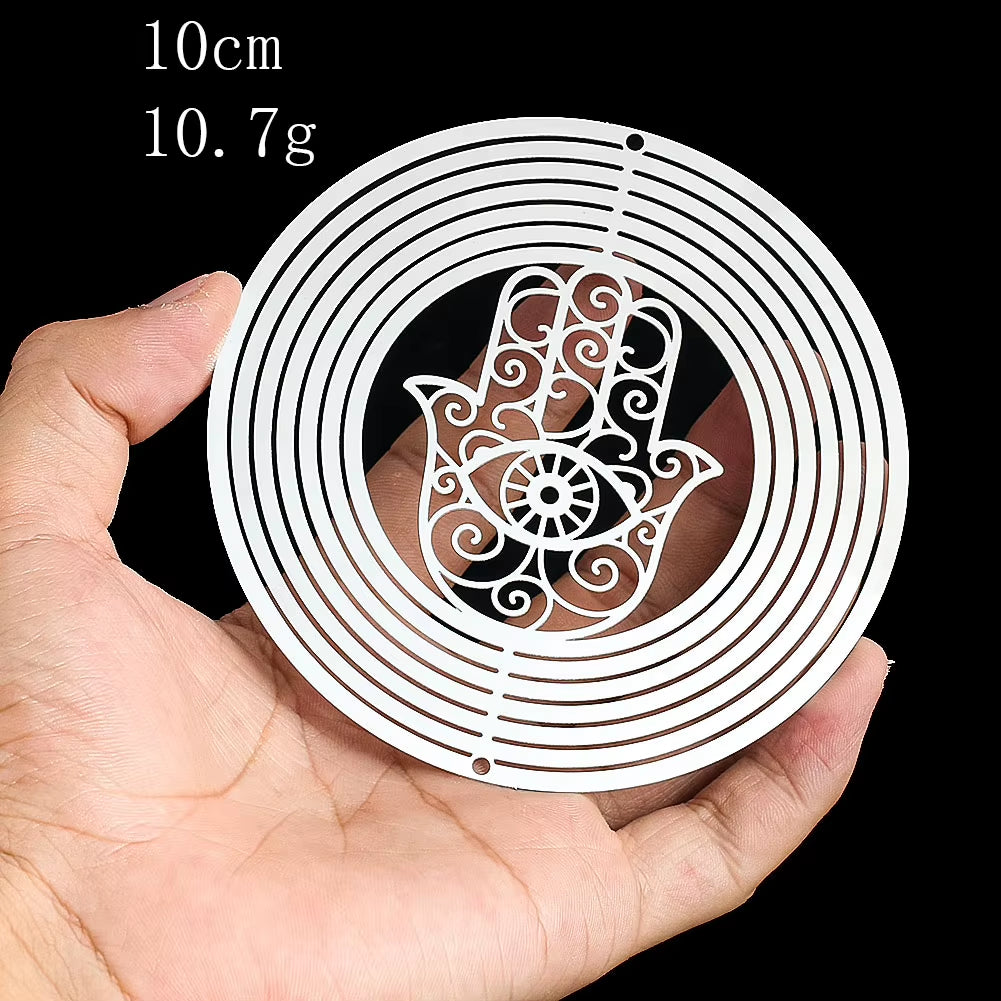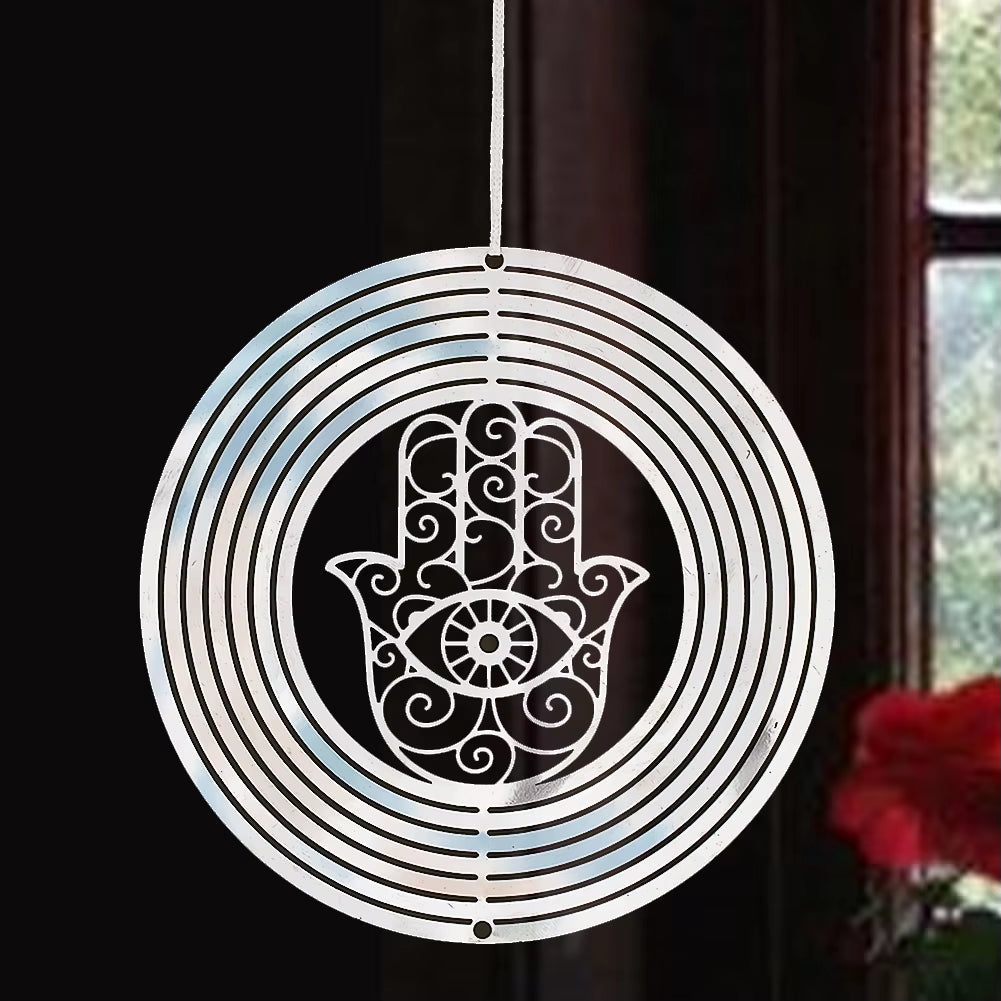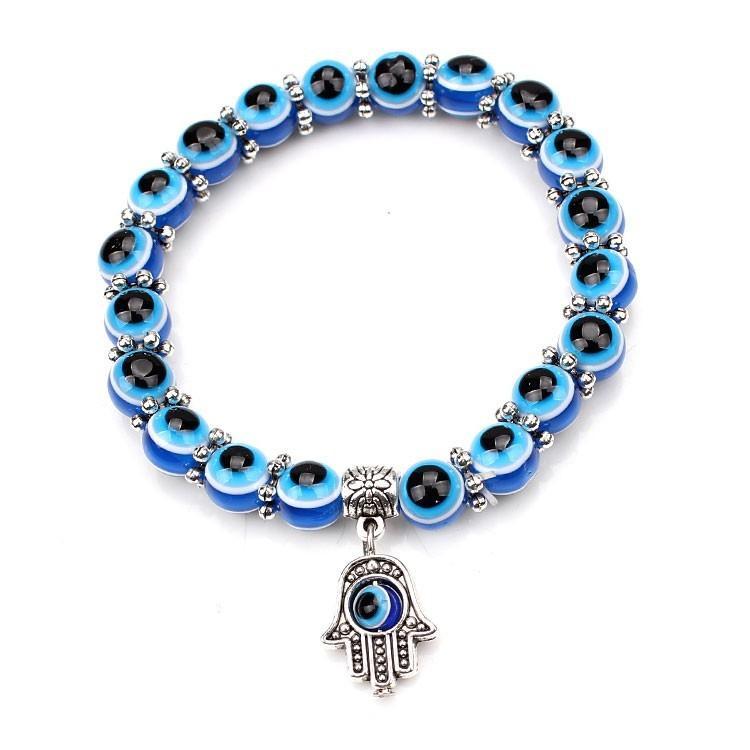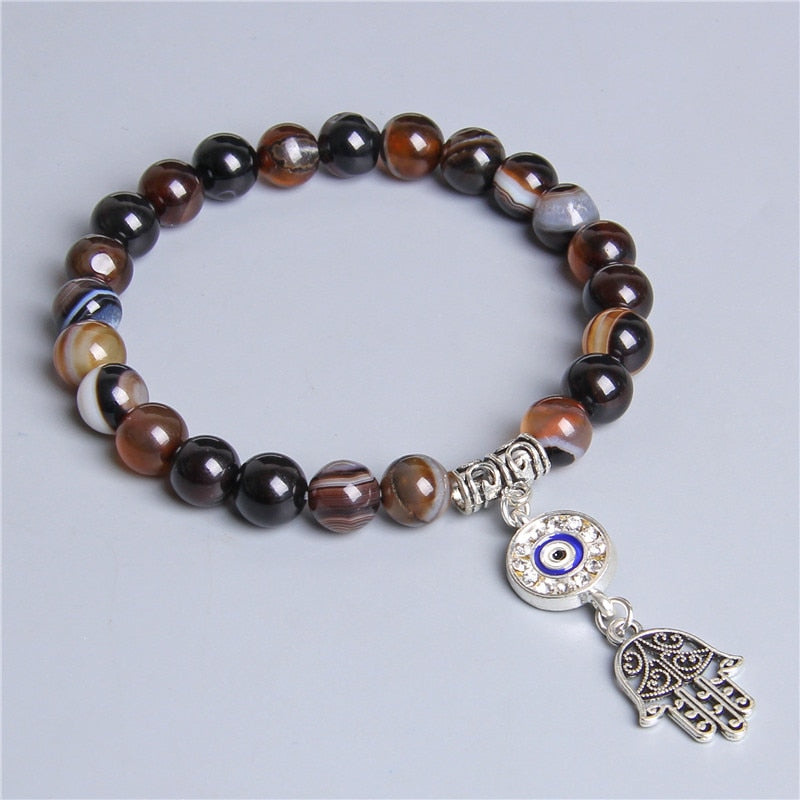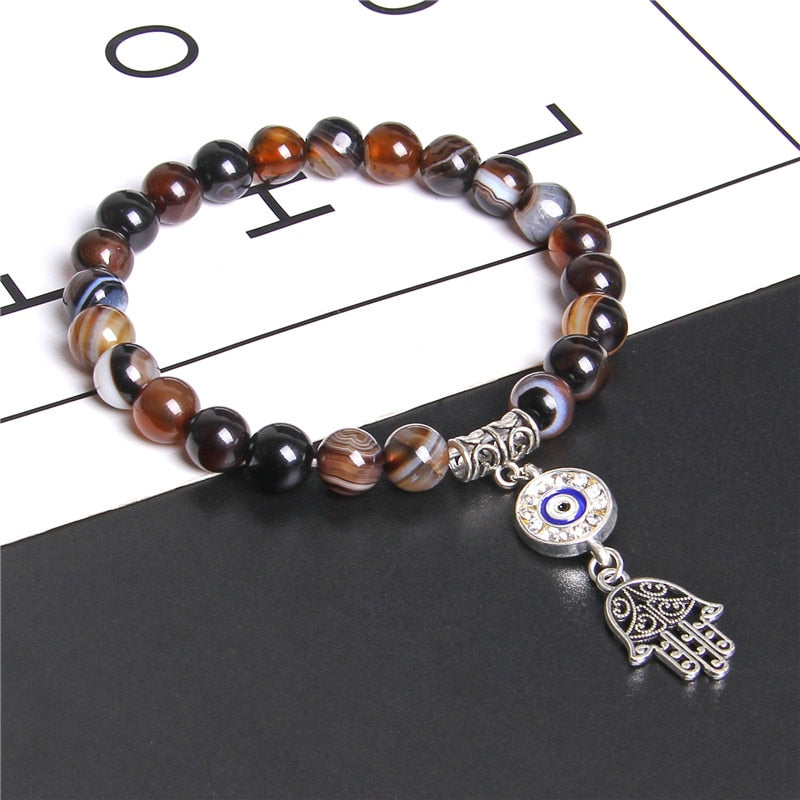Die Hamsa-Hand ist ein uraltes und faszinierendes Symbol, das kulturübergreifend und zeitübergreifend als kraftvolles Symbol für Schutz, Segen und Glück gilt. Wenn Sie sich von ihrer komplexen Schönheit und tiefen spirituellen Resonanz angezogen fühlen, sind Sie nicht allein. Viele spirituell interessierte Menschen suchen die Hamsa wegen ihrer Fähigkeit, Negativität abzuwehren und positive Energien in ihr Leben zu lassen. Dieser umfassende Leitfaden erkundet die volle Bedeutung der Hamsa-Hand , geht auf ihre vielfältigen Ursprünge ein und beleuchtet ihre anhaltende Bedeutung im modernen Leben. Entdecken Sie die reiche Vielfalt an Traditionen und die kraftvolle spirituelle Essenz, die die Hamsa-Hand zu einem geschätzten Symbol für Schutz und Wohlbefinden macht.
Was ist die Hamsa-Hand?
Die Hamsa-Hand , auch bekannt als Hand der Fatima, Hand der Maria oder Hand der Miriam, ist ein altes Amulett aus dem Nahen Osten, das Schutz symbolisiert. Optisch hat sie die Form einer Handfläche, oft mit einem Auge in der Mitte der Handfläche. Das Wort „Hamsa“ leitet sich vom semitischen Wortstamm für „fünf“ ab und bezieht sich auf die fünf Finger der Hand. Dieses ikonische Hamsa-Symbol ist nicht an eine einzelne Religion gebunden, sondern findet sich in verschiedenen Kulturen, darunter Judentum, Islam, Christentum und Buddhismus. Jede Kultur hat eine einzigartige Bedeutung, teilt aber das übergreifende Thema eines schützenden Talismans. Ihre anhaltende Präsenz in unterschiedlichen Traditionen unterstreicht ihre universelle Anziehungskraft als Beschützer vor Schaden und Spender von Segen.
Die tiefe Bedeutung und Symbolik der Hamsa-Hand
Die Bedeutung der Hamsa-Hand ist vielfältig und konzentriert sich vor allem auf Schutz, Kraft und Stärke. Sie gilt als Schutz vor dem „bösen Blick“, einem bösartigen Blick, der Unglück oder Verletzungen verursachen soll. Die offene rechte Hand ist ein Zeichen des Schutzes und steht zugleich für Segen, Kraft und Stärke.
Zu den wichtigsten symbolischen Elementen, die häufig in der Hamsa zu finden sind, gehören:
- Das Auge: Das Auge (normalerweise ein böser Blick) wird oft in der Handfläche dargestellt und ist selbst ein mächtiges Symbol, um negative Energie abzuwehren und den Träger vor Schaden zu bewahren.
- Die Finger: Die fünf Finger können je nach Kultur unterschiedliche Konzepte darstellen. Manchmal symbolisieren sie die fünf Säulen des Islam oder die fünf Bücher der Thora. Gespreizte Finger sollen Unheil abwehren, geschlossene Finger sollen Glück bringen.
- Handrichtung: Eine nach oben gerichtete Hamsa-Hand (mit den Fingern zum Himmel) gilt als universelles Zeichen gegen das Böse. Sie ist ein Schutzzeichen und bringt Glück, Freude, Gesundheit und Wohlstand. Eine nach unten gerichtete Hamsa-Hand (mit den Fingern zur Erde) wird oft als Geste des Segens und des Überflusses interpretiert.
Die spirituelle Bedeutung der Hamsa-Hand umfasst auch Konzepte der Weiblichkeit, insbesondere in Verbindung mit Figuren wie Fatima (Tochter des Propheten Mohammed) und Maria (Mutter Jesu), die göttliches Mitgefühl und mütterlichen Schutz symbolisieren. Sie ist ein Leuchtfeuer der Hoffnung, Stärke und Sicherheit und führt den Menschen auf einen Weg positiver Energie und spirituellen Wohlbefindens.

Ursprünge und kulturelle Wurzeln der Hamsa
Die Ursprünge der Hamsa-Hand liegen weit zurück und reichen bis in die Zeit vor vielen der großen Religionen, die sie übernommen haben. Archäologische Funde deuten auf ihre Verwendung in Mesopotamien (dem heutigen Irak) und im antiken Karthago (dem heutigen Tunesien) hin. Sie ist ein Symbol, das geografische und religiöse Grenzen überwunden hat und zu einem gemeinsamen Schutzsymbol geworden ist.
In der islamischen Kultur wird die Hamsa oft als „Hand der Fatima“ bezeichnet und stellt die Tochter des Propheten Mohammed dar. Sie symbolisiert die fünf Säulen des Islam und wird für ihre schützenden Eigenschaften geschätzt. Detailliertere Informationen zu ihrer Bedeutung in der islamischen Tradition finden Sie in wissenschaftlichen Artikeln zur islamischen Kunst und Symbolik.
In der jüdischen Tradition ist sie als „Hand Mirjams“, der Schwester von Moses und Aaron, bekannt. Sie symbolisiert die Hand Gottes und wird mit den fünf Büchern der Thora in Verbindung gebracht. Die Hamsa ist ein beliebtes Motiv in jüdischem Schmuck und Kunst und wird oft als Schutzamulett verwendet. Mehr über ihre jüdische Bedeutung erfahren Sie auf Quellen wieMy Jewish Learning .
Einige Formen des levantinischen Christentums erkennen die Hamsa auch als „Hand Mariens“ an, die Stärke und göttlichen Schutz symbolisiert. Ihre Präsenz in verschiedenen Glaubensrichtungen unterstreicht den gemeinsamen Wunsch des Menschen nach Schutz vor unsichtbaren negativen Kräften. Für einen umfassenden historischen Überblick bieten maßgebliche Quellen wie die Encyclopedia Britannica wertvolle Informationen zur weiten Verbreitung des Symbols.
Die Hamsa-Hand zum Schutz im modernen Leben
Auch heute noch ist die Hamsa-Hand ein geschätztes Symbol für Schutz, Glück und Führung. Viele Menschen tragen Hamsa-Hand-Schmuck wie Halsketten oder Armbänder nicht nur wegen der Ästhetik, sondern auch wegen der vermeintlichen Fähigkeit, Negativität abzuwehren und positive Energien anzuziehen. Die Frage „Ist es in Ordnung, eine Hamsa-Hand zu tragen?“ wird oft gestellt, und die Antwort lautet im Allgemeinen „Ja“, insbesondere wenn man sie mit Respekt und Verständnis für ihre kulturelle und spirituelle Bedeutung trägt. Sie dient als persönliches Amulett, als Erinnerung an innere Stärke und als Verbindung zu alten Schutztraditionen.

Die schützenden Eigenschaften der Hamsa können auch in Ihren persönlichen Bereich übertragen werden. Ein Hamsa-Handamulett im Haus oder Garten soll Schutz vor negativen Einflüssen bieten und so eine Atmosphäre des Friedens und der Gelassenheit fördern. Dieser anhaltende Glaube an ihre Kraft macht die Hamsa zu einer beliebten Wahl für alle, die sowohl spirituellen Trost als auch einen Hauch bedeutungsvoller Kunst in ihrem Leben suchen.
3D-Windspiel-Amulett aus Edelstahl für den Garten
$22.90 $29.90
Holen Sie sich mit diesem eleganten Windspiel aus Edelstahl die schützende Energie der Hamsa-Hand in Ihr Haus oder Ihren Garten.
Produkt entdeckenMöglichkeiten zur Einbindung des Hamsa-Symbols
Die Vielseitigkeit der Hamsa-Hand ermöglicht es, sie in verschiedene Lebensbereiche zu integrieren und ihre schützenden und positiven Energien überall dort einzusetzen, wo sie platziert wird. Hier sind einige beliebte Möglichkeiten, das Hamsa-Zeichen zu nutzen:
- Schmuck: Das Tragen eines Hamsa-Armbands , einer Halskette oder von Ohrringen ist wohl die häufigste Art, das Symbol nah bei sich zu tragen. Es dient als persönlicher Talisman und erinnert den Träger ständig an seine schützenden Eigenschaften und seine spirituelle Bedeutung.
- Wohndeko: Hamsa-Wandbehänge, Wandteppiche, Skulpturen oder sogar in Windspiele integriert können einen Ort der Ruhe und des Schutzes in Ihrem Zuhause schaffen. Das Platzieren einer Hamsa in der Nähe eines Eingangs soll das Eindringen negativer Energien verhindern.
- Kunst und Tattoos: Für manche ist ein Hamsa-Handtattoo ein dauerhaftes Zeichen ihrer Verbundenheit mit der Symbolik und eine Möglichkeit, ihre schützende Kraft stets bei sich zu tragen. Kunstwerke mit der Hamsa können zudem eine schöne und bedeutungsvolle Ergänzung für jeden Raum sein.
- Schlüsselanhänger und Anhänger: Kleinere Hamsa-Anhänger können an Schlüsselanhängern, Taschen oder Rückspiegeln befestigt werden und bieten unterwegs ein wenig Schutz.

Die Integration der Hamsa in Ihr Leben ist eine persönliche Reise. Ob als dezentes Schmuckstück oder als auffälliges Wohnaccessoire – ihre Präsenz soll Trost, Wohlbefinden und ein Gefühl der Verbundenheit mit einer kraftvollen alten Tradition vermitteln.
Schmücken Sie sich mit Hamsas Segen
$29.99
$39.99
Tragen Sie die vereinte Kraft der Hamsa-Hand und des bösen Blicks für täglichen Schutz und Stil mit diesem bezaubernden Armband aus blauen Perlen. Mehr erfahren ➔
$29.99
$39.99
Tragen Sie das Hamsa-Handsymbol auf diesem Edelsteinarmband, das Ihren Tag mit Kraft, Fülle und Sicherheit erfüllen soll. Mehr erfahren ➔
Hauptvorteile der Hamsa-Hand:
- Schutz: Wehrt negative Energie und den bösen Blick ab.
- Glück: Zieht Glück, Freude und Wohlstand an.
- Stärke und Kraft: Symbolisiert Widerstandsfähigkeit und innere Stärke.
- Gesundheit und Wohlbefinden: Fördert geistiges und körperliches Wohlbefinden.
- Göttlicher Segen: Steht für göttliche Führung und Mitgefühl.
Die Hamsa-Hand: Ein Symbol der Einheit und des gemeinsamen Erbes
Über ihre individuellen Schutzeigenschaften hinaus ist die Hamsa-Hand ein bemerkenswertes Symbol des gemeinsamen menschlichen Erbes und der spirituellen Verbundenheit. Ihre Verbreitung und Verehrung in unterschiedlichen Kulturen und Religionen – vom Nahen Osten bis Nordafrika und darüber hinaus – zeugt von der universellen menschlichen Sehnsucht nach Sicherheit, Segen und Verbundenheit mit etwas Größerem. Das Hamsa-Symbol ist daher nicht nur ein Amulett, sondern auch ein Zeugnis der Verbundenheit menschlicher Glaubenssysteme und der anhaltenden Kraft von Symbolen, über verschiedene Glaubensrichtungen und Traditionen hinweg tiefe Bedeutung zu vermitteln. Es erinnert uns daran, dass trotz unterschiedlicher Interpretationen die grundlegenden Wünsche nach Schutz, Frieden und Wohlstand allen gemeinsam sind.
Fazit: Nutzen Sie die Kraft der Hamsa
Die Hamsa-Hand ist weit mehr als nur ein antikes Artefakt oder ein schönes Design; sie ist ein kraftvolles Symbol voller Bedeutung, Geschichte und spiritueller Kraft. Von ihren Ursprüngen als Schutz vor dem Bösen bis hin zu ihrer modernen Interpretation als Symbol für Frieden, Schutz und Wohlstand findet die Hamsa-Hand nach wie vor tiefe Resonanz bei Menschen, die eine Verbindung zu ihrer zeitlosen Energie suchen. Wenn Sie ihre vielfältigen kulturellen Bedeutungen und die Tiefe ihrer Symbolik verstehen, können Sie ihren Wert in Ihrem Leben besser einschätzen.
Ob Sie ein Hamsa-Armband zum persönlichen Schutz tragen, ein Hamsa-Amulett in Ihrem Zuhause für eine ruhige Atmosphäre aufstellen oder einfach nur ihre historische und spirituelle Tiefe bewundern – die Hamsa kann ein wichtiger Schritt auf Ihrem Weg zu Wohlbefinden und persönlichem Wachstum sein. Entdecken Sie die Kollektion von Healing Sounds und finden Sie ein Hamsa-Stück, das Sie anspricht, und lassen Sie seine uralten Segnungen in Ihr Leben einziehen.
Häufig gestellte Fragen zur Hamsa-Hand
Die Bedeutung der Hamsa-Hand besteht in erster Linie darin , vor dem bösen Blick und negativen Energien zu schützen . Sie symbolisiert auch Segen, Kraft, Stärke, Glück und Wohlstand. Die offene rechte Hand ist ein universelles Zeichen der Verteidigung und des göttlichen Schutzes.
Ja, es ist im Allgemeinen völlig in Ordnung, eine Hamsa-Hand zu tragen , unabhängig von Ihren persönlichen Überzeugungen oder Ihrer Herkunft, solange sie mit Respekt vor ihrer kulturellen und spirituellen Bedeutung getragen wird. Viele Menschen tragen sie als Symbol des Schutzes, des Glücks oder als modisches Statement mit tiefer Bedeutung.
Das 🪬 Emoji stellt die Hamsa-Hand dar. Es wird in der digitalen Kommunikation verwendet, um dieselben Bedeutungen wie das physische Amulett zu vermitteln: Schutz, Segen, Glück und Abwehr vor dem bösen Blick oder Negativität.
Die Hamsa-Hand wird in der Bibel nicht ausdrücklich erwähnt . Ihre Ursprünge liegen vor oder außerhalb der primären biblischen Erzählung und stammen eher aus alten Kulturen des Nahen Ostens und Nordafrikas. Obwohl einige Christen im Nahen Osten sie mit der Hand Mariens assoziieren, ist sie per se kein biblisches Symbol, und die Interpretationen von Amuletten variieren zwischen den christlichen Konfessionen.
Nein, die Hamsa-Hand gilt nicht als böse. Im Gegenteil, sie gilt weithin als mächtiges Symbol des Schutzes vor Bösem, Unglück und negativen Kräften. Sie wird in vielen Kulturen als Talisman für Glück, Segen und göttlichen Schutz geschätzt.

